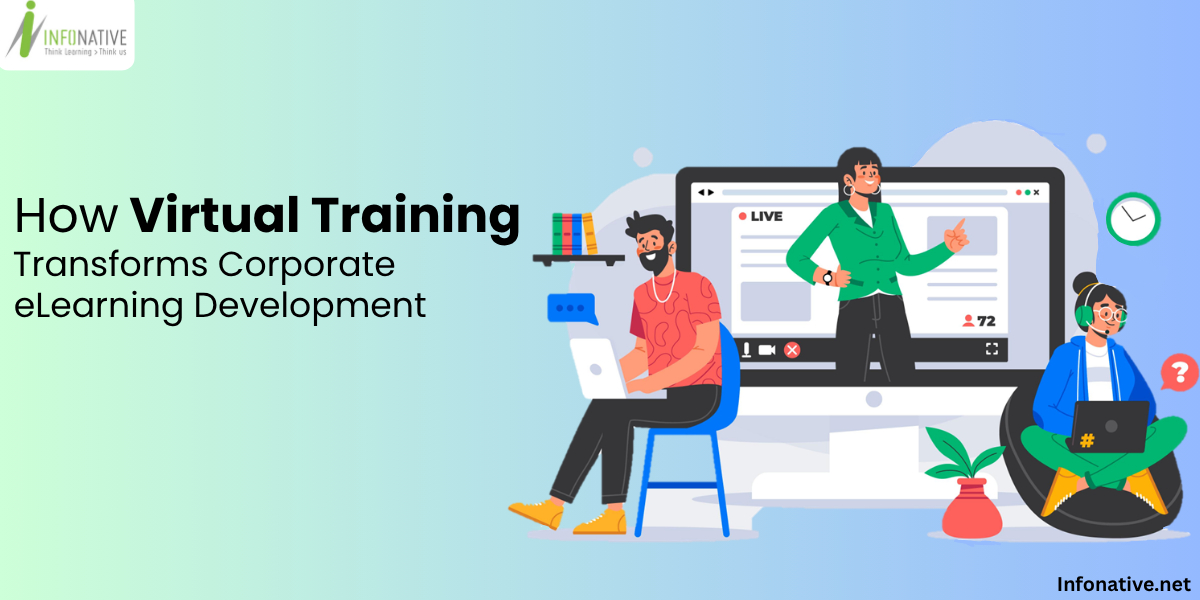The shift to virtual training is one of the most significant transformations in the world of corporate eLearning development. Traditional classroom settings are quickly becoming obsolete as companies embrace technology-driven solutions that improve flexibility, reduce costs, and enhance learning outcomes.
Virtual training empowers organizations to deliver education through digital platforms, helping employees learn anytime, anywhere. With advancements in artificial intelligence, cloud computing, and LMS integrations, corporate eLearning has become more personalized, efficient, and scalable.
What is Virtual Training?
Virtual training refers to learning delivered through digital platforms, allowing employees to participate from any location It features a blend of instructor-led sessions, live webinars, virtual classrooms, interactive simulations, and self-paced learning modules. These training sessions are typically hosted through Learning Management Systems (LMS), video conferencing tools, or custom eLearning platforms.
Why Corporate eLearning Needs Virtual Training
Traditional classroom training is often time-consuming, expensive, and logistically challenging—especially for global teams. Virtual training addresses these limitations by offering:
• Accessibility from anywhere
• Cost-effective delivery
• Self-paced learning opportunities
• Quick content updates
• Interactive and immersive experiences
These advantages make it a powerful solution for corporate eLearning development.
1. Enhanced Scalability and Reach
Virtual training enables companies to train thousands of employees across locations without geographical barriers. Whether it’s onboarding new hires or upskilling existing staff, a single digital module can reach a global workforce instantly.
For multinational corporations, this scalability is critical. They are capable of delivering uniform training experiences across different time zones, languages, and geographic locations without disruption.
2. Personalized Learning Experience
Modern virtual training tools are equipped with AI-driven adaptive learning systems that tailor content based on user performance. This approach enables employees to learn at their own pace and according to their skill levels.
For example, a sales representative may need more focus on negotiation techniques, while a marketing professional may require content related to branding. Personalized paths increase learning retention and employee engagement.
3. Cost Efficiency
A key advantage of virtual training is its ability to significantly lower costs. It eliminates expenses related to:
• Travel and accommodation
• Venue rentals
• Printed training materials
• Instructor fees for multiple sessions
Moreover, once a digital course is created, it can be reused or updated with minimal cost, maximizing return on investment (ROI).
4. Increased Engagement with Multimedia and Interactivity
Corporate eLearning development is greatly enhanced when virtual training incorporates multimedia elements such as videos, quizzes, infographics, and gamification.
Interactive components like real-time polls, breakout rooms, and discussion forums encourage participation. Moreover, Virtual Reality (VR) and Augmented Reality (AR) offer interactive, immersive experiences that enable practical training within a risk-free environment.
These elements significantly improve knowledge retention and learner satisfaction.
5. Real-Time Data and Analytics
Virtual training platforms provide in-depth analytics to measure:
• Learner progress
• Assessment scores
• Course completion rates
• Engagement levels
These insights help organizations refine training programs, identify skill gaps, and align learning outcomes with business goals.
For instance, if a module on cybersecurity shows low quiz scores across departments, targeted remedial training can be deployed quickly.
6. Rapid Deployment and Updates
In industries where compliance and regulations change frequently (e.g., finance, healthcare, IT), the ability to update training material in real time is essential.
Virtual training allows organizations to modify content and roll out updates instantly without printing new manuals or scheduling new workshops. This ensures the workforce always has access to the latest information.
7. Supports a Hybrid and Remote Workforce
Post-pandemic, hybrid and remote work have become the norm. Virtual training connects onsite and remote teams, ensuring everyone receives the same quality of learning, regardless of location.
It fosters a culture of continuous learning regardless of physical location, which is essential for employee development and satisfaction in today’s digital workplace.
How to Implement Virtual Training in Corporate eLearning
Shifting to virtual training demands careful preparation and strategic implementation. Here are key steps:
a. Assess Training Needs
Assess the skill and knowledge gaps in your organization to ensure the virtual training program effectively supports your business goals.
b. Choose the Right Platform
Choose a powerful Learning Management System (LMS) or virtual training platform that ensures scalability, seamless integration, in-depth analytics, and an intuitive user experience.
c. Develop Engaging Content
Focus on creating interactive and engaging modules. Include videos, simulations, quizzes, and case studies that align with real-world job scenarios.
d. Train the Trainers
Instructors and facilitators should be trained to deliver effective virtual sessions, manage online tools, and engage remote learners.
e. Gather Feedback and Improve
Collect learner feedback regularly to refine your approach. Leverage data insights to spot patterns and improve the overall learning experience.
Future of Virtual Training in Corporate eLearning
As technologies like AI, VR, AR, and machine learning continue to evolve, virtual training will become even more dynamic and intelligent.
Here are emerging trends to watch:
• AI-based Learning Assistants
• Virtual Reality for skill simulation
• Gamified microlearning modules
• Chatbots for instant learner support
• Integration with HR systems for performance tracking
The fusion of these technologies will make corporate eLearning more engaging, efficient, and result-driven.
Conclusion
Virtual training is no longer a temporary solution—it is a transformational force in corporate eLearning development. It empowers organizations to upskill employees, improve productivity, and adapt to the changing demands of the modern workplace.
By adopting virtual training, companies not only future-proof their workforce but also foster a culture of continuous learning and innovation.




